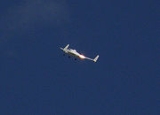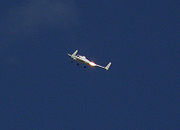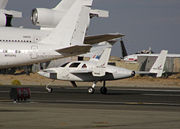
XCOR Aerospace
Encyclopedia
XCOR Aerospace is an American private rocket engine
and spaceflight
development company based at the Mojave Spaceport
in Mojave, California
. XCOR was formed by former members of the Rotary Rocket
rocket engine development team in September, 1999. XCOR is headed by Jeff Greason
who is the CEO.
company.


 Projects have included:
Projects have included:
(ULA) announced they had entered into a joint-development contract with XCOR for a flight-ready, 25000 to 30000 lbf (111,205.5 to 133,446.6 N) cryogenic LH2/LOX
upper-stage rocket engine. Partially as a result of positive results achieved from an earlier (2010) effort to develop a new aluminum alloy engine nozzle using innovative manufacturing techniques, ULA believes the new engine technology will shave several hundred pounds of weight from the large engine and will "lead to significantly lower-cost and more-capable commercial and US government space flights."
The "multi-year project’s main objective is to produce a flight-ready LOX/LH2 upper-stage engine in the 25000 to 30000 lbf (111.2 to 133.4 kN)-thrust class that costs significantly less to produce and is easier to operate and integrate than competing engine technologies"
"The demonstrations announced [on March 22, 2011] are from integrated engine/nozzle test firings with XCOR’s Lynx 5K18 LOX/kerosene engine. The engine/nozzle combination demonstrates the ability of the aluminum nozzle to withstand the high temperatures of rocket-engine exhaust over numerous tests, with no discernable degradation of the material properties of the alloys. The tests validated the design, materials and manufacturing processes used in the nozzle, and laid a foundation for scaling the design to EELV-sized engines."
The length of the development program will depend on "the level of investment as milestones are met in the build-a-little, test-a-little approach favored by XCOR." If investment is minimized, flight engines would not be available, , for five to ten years.
Rocket engine
A rocket engine, or simply "rocket", is a jet engineRocket Propulsion Elements; 7th edition- chapter 1 that uses only propellant mass for forming its high speed propulsive jet. Rocket engines are reaction engines and obtain thrust in accordance with Newton's third law...
and spaceflight
Spaceflight
Spaceflight is the act of travelling into or through outer space. Spaceflight can occur with spacecraft which may, or may not, have humans on board. Examples of human spaceflight include the Russian Soyuz program, the U.S. Space shuttle program, as well as the ongoing International Space Station...
development company based at the Mojave Spaceport
Mojave Spaceport
thumb|right|235px|A retired [[Boeing 767-200]] that flew for [[Ansett Australia]] being cut open for scrap at Mojave AirportThe Mojave Air and Space Port , also known as the Civilian Aerospace Test Center, is located in Mojave, California, at an elevation of...
in Mojave, California
Mojave, California
Mojave is a census-designated place in Kern County, California, United States. Mojave is located east of Bakersfield, at an elevation of 2762 feet...
. XCOR was formed by former members of the Rotary Rocket
Rotary Rocket
Rotary Rocket, Inc, was a rocketry company headquartered in a facility at Mojave Airport that developed the Roton concept in the late 1990s as a fully reusable single-stage-to-orbit manned spacecraft. Roton was intended to reduce costs of launching payloads into low earth orbit by a factor of...
rocket engine development team in September, 1999. XCOR is headed by Jeff Greason
Jeff Greason
Jeff Greason is a founder of XCOR Aerospace, the Commercial Spaceflight Federation , was the team lead at Rotary Rocket for engine development, and previously worked at Intel....
who is the CEO.
Key people
Jeff Greason, Dan DeLong, Aleta Jackson and Doug Jones previously worked at the failed Rotary RocketRotary Rocket
Rotary Rocket, Inc, was a rocketry company headquartered in a facility at Mojave Airport that developed the Roton concept in the late 1990s as a fully reusable single-stage-to-orbit manned spacecraft. Roton was intended to reduce costs of launching payloads into low earth orbit by a factor of...
company.
Projects



- EZ-Rocket, a Rutan Long-EZRutan Long-EZ-See also:-External links:****...
homebuilt aircraft fitted with two 400 lbfPound-forceThe pound force is a unit of force in some systems of measurement including English engineering units and British gravitational units.- Definitions :...
(1.8 kN) thrust rocket engines replacing the normal propeller engine. EZ-Rocket has been flown at numerous airshows including the 2005 Oshkosh AirshowOshkosh AirshowEAA AirVenture Oshkosh is America's largest annual gathering of aviation enthusiasts held each summer at Wittman Regional Airport in Oshkosh, Wisconsin, United States....
. - Rocket Racer - The EZ-Rocket program led to a second rocketplane design for the Rocket Racing LeagueRocket Racing LeagueThe Rocket Racing League is a proposed racing league that would use rocket-powered aircraft to race a closed-circuit air racetrack. Founded in 2005, the league is currently working to hold the first multi-vehicle races in 2011...
. It was built on a Velocity SEVelocity SEThe Velocity SE is the entry level canard pusher aircraft from Velocity Aircraft.The four seat, rear engine aircraft may be powered by a Lycoming IO-320 or a Lycoming IO-360 engine.- See also :* Velocity XL* Rutan Long-EZ...
airframe and later became known as the Mark-I X-Racer. It was powered by an XCOR regeneratively-cooled and pump-fed XR-4K14 rocket engine. This rocket-powered aircraft flew several demonstration flights at the 2008 EAA AirVenture Oshkosh air showAir showAn air show is an event at which aviators display their flying skills and the capabilities of their aircraft to spectators in aerobatics. Air shows without aerobatic displays, having only aircraft displayed parked on the ground, are called "static air shows"....
. The total thrust for the single-engine Mark-I X-Racer has been variously reported as 1500 lbf (6,672.3 N) to 1800 lbf (8,006.8 N), approximately twice that of the EZ-Rocket initial prototype. The engine uses pressure-fed LOX and pump-fed kerosene, a combination that allows the fuel to be stored in the airplane's wing tanks while avoiding potential complications with pumping liquid oxygen.
- The LynxLynx rocketplaneThe Lynx rocketplane is a suborbital horizontal-takeoff, horizontal-landing ,rocket-powered spaceplane being developed by the California-based company XCOR to compete in the emerging suborbital space flight market. The Lynx is projected to carry one pilot, a ticketed passenger, and/or a payload or...
, capable of carrying a pilot and a passenger or payload on sub-orbital spaceflightSub-orbital spaceflightA sub-orbital space flight is a spaceflight in which the spacecraft reaches space, but its trajectory intersects the atmosphere or surface of the gravitating body from which it was launched, so that it does not complete one orbital revolution....
s over 100 km. Between 20 and 50 test flights of Lynx are planned, along with numerous static engine firings on the ground. A full step-by-step set of taxi tests, runway hops and full-up flights are planned to get the vehicle to a state of operational readiness. Lynx is envisaged to be roughly the size of a small private airplane. It would be capable of flying several times a day making use of reusable, non-toxic engines to help keep the space plane's operating costs low. The Lynx supersedes a previous design, the Xerus spaceplaneXerus (spaceplane)Xerus , was a suborbital spaceplane concept proposed by XCOR Aerospace. It would be capable of transporting one pilot and one passenger as well as some science experiments and it would even be capable of carrying an upper stage which would launch near apogee and therefore would potentially be able...
. The Lynx was initially announced on March 26, 2008, with plans for an operational vehicle within two years. That date has since slipped to early 2012. The Mark II would fly nine to eighteen months afterwards depending on how fast the prototype moves through the test program.
- Tea cart engine, a 15 lbf (67 N) thrust rocket motor burning nitrous oxideNitrous oxideNitrous oxide, commonly known as laughing gas or sweet air, is a chemical compound with the formula . It is an oxide of nitrogen. At room temperature, it is a colorless non-flammable gas, with a slightly sweet odor and taste. It is used in surgery and dentistry for its anesthetic and analgesic...
and ethaneEthaneEthane is a chemical compound with chemical formula C2H6. It is the only two-carbon alkane that is an aliphatic hydrocarbon. At standard temperature and pressure, ethane is a colorless, odorless gas....
, mounted on a small industrial cart. The tea cart engine has repeatedly been fired indoors at conferences and demonstrations and had accumulated over 1,837 firings and 9,039 seconds of run time by February 25, 2009. - LOX-methane rocket engines in testing in 2005.
- Early LOX-methane work led to a NASA contract, jointly with ATKAlliant TechsystemsAlliant Techsystems Inc., most commonly known by its ticker symbol, ', is one of the largest aerospace and defense companies in the United States with more than 18,000 employees in 22 states, Puerto Rico and internationally, and 2010 revenues in excess of an estimated...
, to develop a 7500 lbf (33,361.7 N) engine for potential use as the CEVOrion (spacecraft)Orion is a spacecraft designed by Lockheed Martin for NASA, the space agency of the United States. Orion development began in 2005 as part of the Constellation program, where Orion would fulfill the function of a Crew Exploration Vehicle....
lunar return engine. On January 16, 2007 XCOR announced the successful test firing of a preliminary "workhorse" version of this engine.
- XCOR has developed Nonburnite (tm), a cryo-compatible, inherently non-combustible composite material based on a thermoplastic fluoropolymer resin. Low coefficient of thermal expansion and inherent resistance to microcracking make it well suited to cryogenic tank use and also part of vehicle structure.
XCOR/ULA liquid-hydrogen, upper-stage engine development project
In March 2011, United Launch AllianceUnited Launch Alliance
United Launch Alliance is a joint venture of Lockheed Martin and Boeing. ULA was formed in December 2006 by combining the teams at these companies which provide spacecraft launch services to the government of the United States. U.S...
(ULA) announced they had entered into a joint-development contract with XCOR for a flight-ready, 25000 to 30000 lbf (111,205.5 to 133,446.6 N) cryogenic LH2/LOX
Lox
Lox is salmon fillet that has been cured. In its most popular form, it is thinly sliced—less than in thickness—and, typically, served on a bagel, often with cream cheese, onion, tomato, cucumber and capers...
upper-stage rocket engine. Partially as a result of positive results achieved from an earlier (2010) effort to develop a new aluminum alloy engine nozzle using innovative manufacturing techniques, ULA believes the new engine technology will shave several hundred pounds of weight from the large engine and will "lead to significantly lower-cost and more-capable commercial and US government space flights."
The "multi-year project’s main objective is to produce a flight-ready LOX/LH2 upper-stage engine in the 25000 to 30000 lbf (111.2 to 133.4 kN)-thrust class that costs significantly less to produce and is easier to operate and integrate than competing engine technologies"
"The demonstrations announced [on March 22, 2011] are from integrated engine/nozzle test firings with XCOR’s Lynx 5K18 LOX/kerosene engine. The engine/nozzle combination demonstrates the ability of the aluminum nozzle to withstand the high temperatures of rocket-engine exhaust over numerous tests, with no discernable degradation of the material properties of the alloys. The tests validated the design, materials and manufacturing processes used in the nozzle, and laid a foundation for scaling the design to EELV-sized engines."
The length of the development program will depend on "the level of investment as milestones are met in the build-a-little, test-a-little approach favored by XCOR." If investment is minimized, flight engines would not be available, , for five to ten years.
See also
- RL10 — a competitive, workhorse upper-stage engine to the XCOR/ULA large upper-stage engine now under development
- Rocket mailRocket mailRocket mail is the delivery of mail by rocket or missile. The rocket would land by deploying an internal parachute upon arrival. It has been attempted by various organizations in many different countries, with varying levels of success...
- X Prize CupX PRIZE CupThe X Prize Cup is a two-day Air & Space Expo which was the result of a partnership between the X Prize Foundation and the State of New Mexico that began in 2004 when the Ansari X-Prize was held. This led to plans to build the world's first true rocket festival. Three X-PRIZE Cups have been held:...

